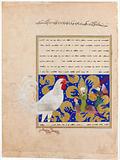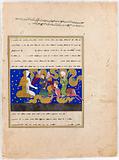Miniature from a copy of al-Sarai’s Nahj al-Faradis (The Paths of Paradise)
Iran, Herat; c. 1465
Leaf: 41.2 × 29.8 cm
The David Collection owns four leaves with seven paintings from a hitherto virtually unknown manuscript commissioned by the Timurid ruler Abu Said (r. 1451-1469). The manuscript deals with the Prophet Muhammad’s mystical ascension to heaven, miraj, which began in Jerusalem and took him to both Paradise and Hell.
Muhammad made the ascension on Buraq, a winged creature that is most often shown with a horse-like body and a woman’s face. He was accompanied on his journey by the archangel Gabriel (Jibril).
On the left of the miniature is a gigantic white cock, which is so large that its head reaches God’s throne and its feet rest on the earth. The artist sought to illustrate its size by letting the cock’s legs and tail extend past the picture frame. Muhammad, who in this and a number of other contemporary manuscripts is shown without a veil covering his face, turns with an inquisitive gesture to Gabriel, who explains that the cock is the angel that keeps track of time and calls the faithful to prayer.
“The Prophet Muhammad Encounters the Angel Half-Fire Half Snow” (verso)
Inv. no. 13/2012
Published in:
recto
Eleanor Sims: “The Nahj al-Faradis of Sultan Abu Sa’id ibn Sultan Muhammad ibn Mirranshah: an illustrated Timurid ascension text of the “Interim” period” in Journal of the David Collection, 4, 2014, cat.no. 1, fig. 13, pp. 118-119;
Deniz Kitir: Klassisk og moderne islam, 2. ed., Aarhus 2020, p. 68;
verso
Eleanor Sims: “The Nahj al-Faradis of Sultan Abu Sa’id ibn Sultan Muhammad ibn Mirranshah: an illustrated Timurid ascension text of the “Interim” period” in Journal of the David Collection, 4, 2014, cat.no. 2, fig. 15, pp. 120-121;
Christiane Gruber: The Praiseworthy One: the Prophet Muhammad in Islamic texts and images, Bloomington 2018, fig. 2.20, p. 129;


